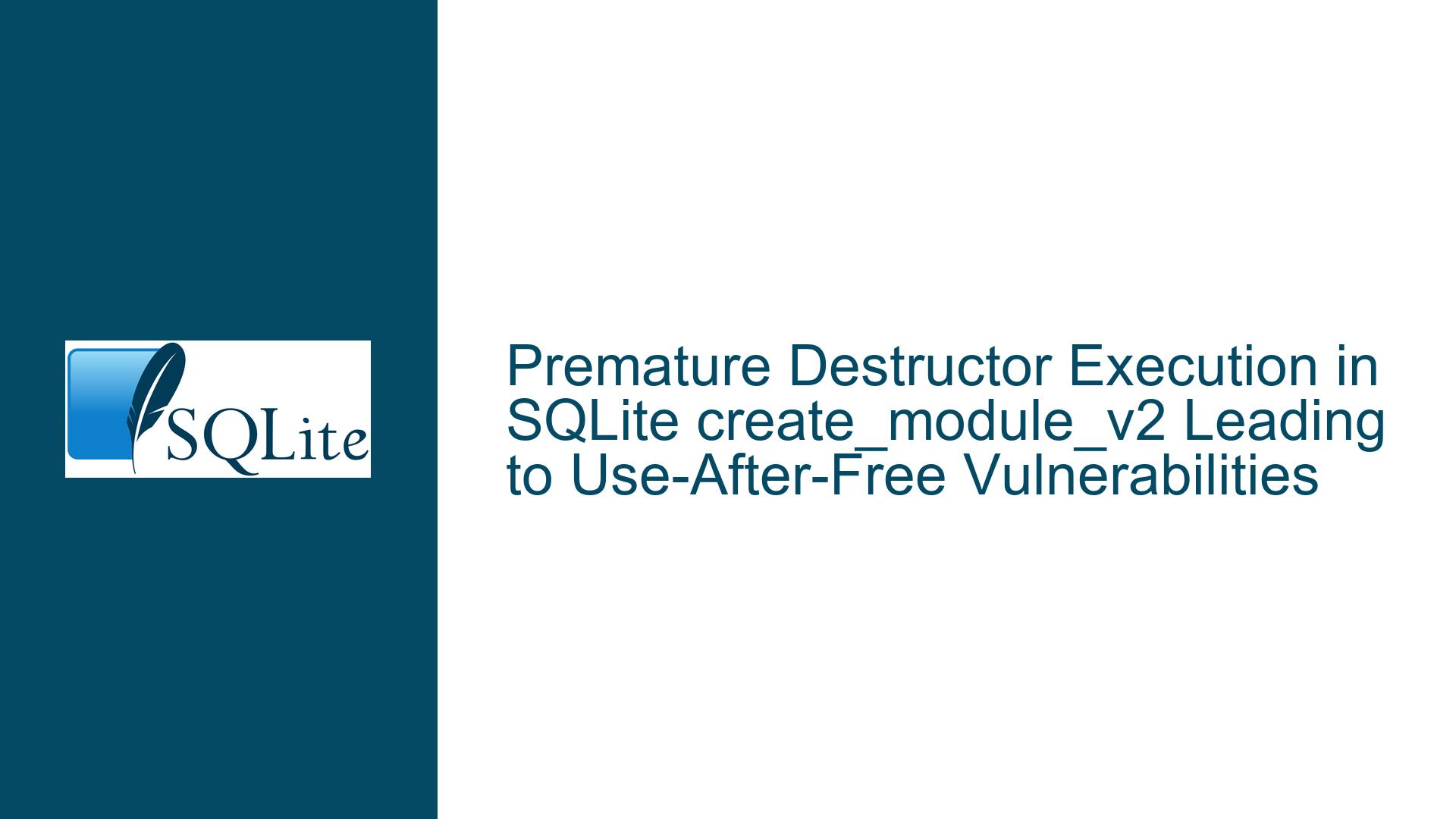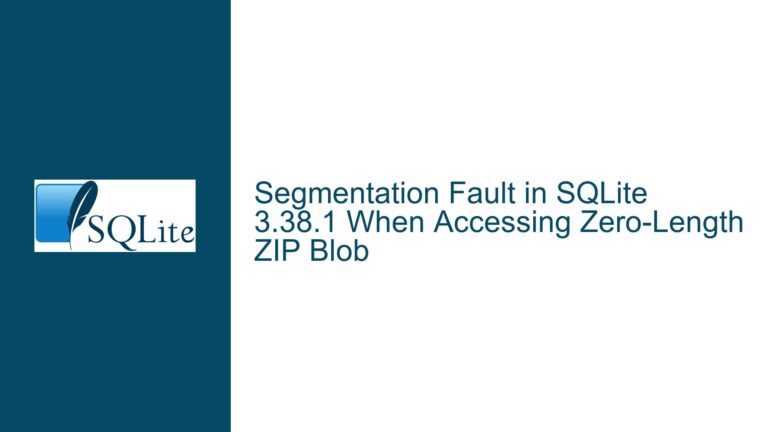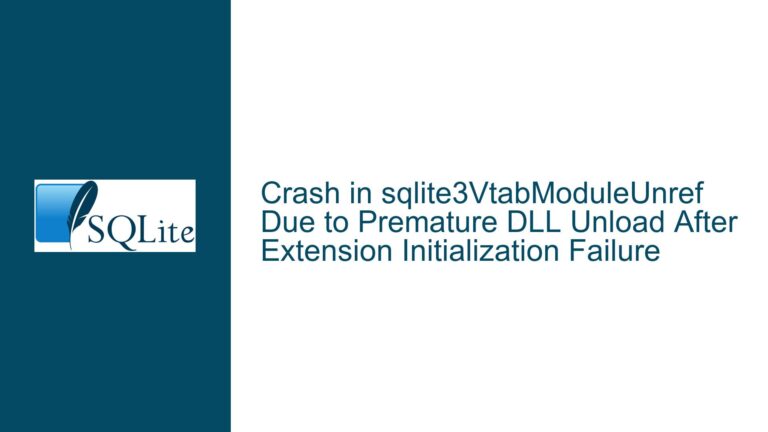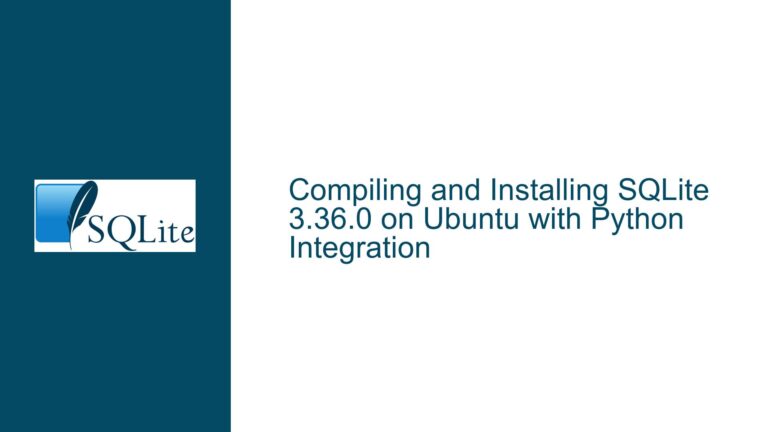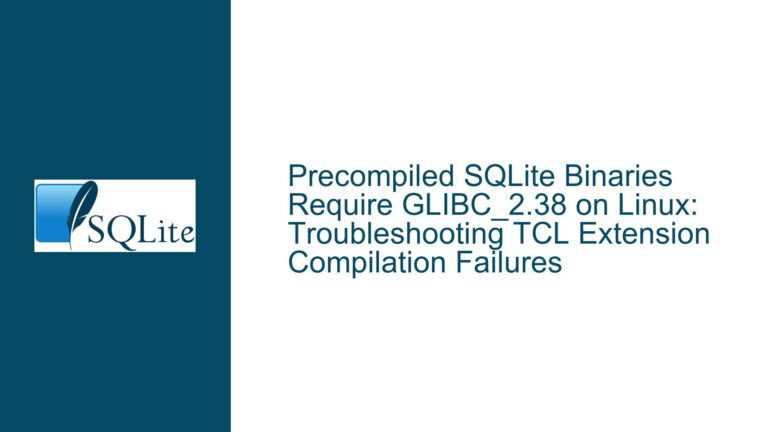Premature Destructor Execution in SQLite create_module_v2 Leading to Use-After-Free Vulnerabilities
Understanding the Lifecycle Mismatch Between Module Destructors and xDisconnect in SQLite Virtual Tables
Issue Overview: Destructor Invocation Precedes xDisconnect in create_module_v2 Workflow
The core issue revolves around the timing of the destructor function registered via SQLite’s sqlite3_create_module_v2 API. This destructor is designed to release resources associated with the client data pointer provided during virtual table module registration. However, under specific conditions, SQLite’s internal cleanup sequence triggers the destructor before invoking the xDisconnect method of the associated sqlite3_module structure. This premature destruction creates a critical vulnerability when the module structure itself is dynamically allocated and its memory is freed within the destructor.
When a virtual table is disconnected (a routine process during database closure or schema changes), SQLite’s internal function sqlite3VtabUnlock initiates two operations:
- It decrements the reference count of the module via
sqlite3VtabModuleUnref, which triggers the registered destructor if the reference count reaches zero. - It subsequently calls the
xDisconnectmethod of thesqlite3_modulestructure to finalize the virtual table instance.
If the module structure is dynamically allocated and the destructor frees its memory, the xDisconnect call dereferences a dangling pointer to the now-freed sqlite3_module structure. This results in undefined behavior, typically manifesting as segmentation faults, heap corruption, or silent data inconsistencies.
The problem is exacerbated in environments where dynamic allocation of the sqlite3_module structure is necessary, such as when supporting multiple module configurations, eponymous-only virtual tables, or version-specific behavior (e.g., differing iVersion values). The SQLite documentation historically recommended using statically allocated modules, but modern use cases increasingly require dynamic lifetime management, exposing this lifecycle mismatch.
Root Causes: Reference Counting Logic and Documentation Assumptions
The premature destructor invocation stems from two interrelated factors:
Incorrect Order of Operations in SQLite’s Internal Cleanup Routines
Thesqlite3VtabUnlockfunction first unreferences the module (potentially triggering destruction) and then callsxDisconnect. This sequence assumes that thesqlite3_modulestructure remains valid throughout thexDisconnectcall, which is only true if the module is statically allocated or intentionally leaked. When the module is dynamically allocated and its lifetime is tied to the destructor, this assumption fails catastrophically.Ambiguity in Documentation Regarding Module Lifetime Management
SQLite’s documentation forsqlite3_create_module_v2states that the destructor is for "client data" associated with the module, not the module structure itself. A separate section notes that thesqlite3_modulepointer should be "persistent and unmodified," implying static allocation. However, this guidance conflicts with legitimate use cases requiring dynamic module allocation, such as:- Modules that alter their behavior based on runtime configuration (e.g., different
xCreateorxConnectmethods). - Libraries that generate modules programmatically to avoid global state.
- Multi-threaded environments where static modules could lead to race conditions.
- Modules that alter their behavior based on runtime configuration (e.g., different
Legacy Design Choices Prioritizing Static Allocation
The originalsqlite3_create_moduleAPI (without a destructor) implicitly required static modules, as there was no mechanism to notify the caller when the module was no longer needed. Thecreate_module_v2extension added destructor support but retained the original cleanup sequence, prioritizing backward compatibility over dynamic allocation scenarios.
Resolution Strategies: Code Modifications, Workarounds, and Version Upgrades
Immediate Workaround: Leak the Module Structure
If upgrading to a fixed SQLite version is not immediately feasible, the simplest workaround is to treat the sqlite3_module structure as a singleton that is never freed. This avoids the use-after-free by ensuring the module remains valid throughout its lifetime, including during xDisconnect:
static sqlite3_module* g_module = NULL;
void register_module(sqlite3* db) {
if (!g_module) {
g_module = (sqlite3_module*)sqlite3_malloc(sizeof(sqlite3_module));
// Initialize g_module fields...
}
sqlite3_create_module_v2(db, "my_module", g_module, NULL, /*xDestroy=*/sqlite3_free);
}
This approach permanently leaks the module structure. While technically a memory leak, the overhead is negligible for most applications, as a single module instance is typically small (around 100 bytes) and persists for the database connection’s duration.
Upgrade to SQLite Version 3.42.0 or Later
The SQLite trunk (as of 2023-01-25) corrected the cleanup sequence to invoke xDisconnect before unreferencing the module. This ensures the destructor runs only after all module methods, including xDisconnect, have completed. Upgrade steps:
- Download the latest SQLite amalgamation from sqlite.org/download.html.
- Replace existing SQLite headers and source files with the updated versions.
- Recompile the application, ensuring all database handles are reinitialized.
Post-upgrade, dynamically allocated modules can safely free their memory in the destructor:
void module_destructor(void* ptr) {
sqlite3_module* module = (sqlite3_module*)ptr;
// Clean up module-specific resources...
sqlite3_free(module);
}
void register_module(sqlite3* db) {
sqlite3_module* module = (sqlite3_module*)sqlite3_malloc(sizeof(sqlite3_module));
// Initialize module fields...
sqlite3_create_module_v2(db, "my_module", module, NULL, module_destructor);
}
Refactor Module Initialization to Use Static Structures
If dynamic allocation is avoidable, revert to static sqlite3_module instances. This eliminates lifetime management complexity entirely:
static const sqlite3_module my_module = {
.iVersion = 1,
.xCreate = my_xCreate,
.xConnect = my_xConnect,
// ... other method initializers
};
void register_module(sqlite3* db) {
sqlite3_create_module_v2(db, "my_module", &my_module, NULL, NULL);
}
Hybrid Approach: Module Pools for Dynamic Configurations
For scenarios requiring multiple module instances with varying configurations (e.g., different iVersion values), maintain a global pool of modules indexed by their configuration parameters. The pool persists for the application’s lifetime, and modules are reused across database connections:
#include <uthash.h>
typedef struct {
int iVersion;
sqlite3_module* module;
UT_hash_handle hh;
} ModulePoolEntry;
static ModulePoolEntry* module_pool = NULL;
sqlite3_module* get_module(int iVersion) {
ModulePoolEntry* entry = NULL;
HASH_FIND_INT(module_pool, &iVersion, entry);
if (!entry) {
entry = (ModulePoolEntry*)sqlite3_malloc(sizeof(ModulePoolEntry));
entry->iVersion = iVersion;
entry->module = (sqlite3_module*)sqlite3_malloc(sizeof(sqlite3_module));
// Initialize module based on iVersion...
HASH_ADD_INT(module_pool, iVersion, entry);
}
return entry->module;
}
void cleanup_module_pool() {
ModulePoolEntry *entry, *tmp;
HASH_ITER(hh, module_pool, entry, tmp) {
HASH_DEL(module_pool, entry);
sqlite3_free(entry->module);
sqlite3_free(entry);
}
}
void register_module(sqlite3* db, int iVersion) {
sqlite3_module* module = get_module(iVersion);
sqlite3_create_module_v2(db, "my_module", module, NULL, NULL);
}
Diagnostic Measures: Detecting Use-After-Free
To identify instances where the module structure is accessed after destruction:
Enable SQLite’s Internal Diagnostics
Compile SQLite with-DSQLITE_DEBUGand setsqlite3_config(SQLITE_CONFIG_LOG, ...)to log module reference count changes.Use Address Sanitizers (ASan)
Recompile the application and SQLite with-fsanitize=addressto detect memory corruption:CFLAGS="-fsanitize=address -g" ./configure makeValgrind Analysis
Run the application under Valgrind to trace invalid memory accesses:valgrind --tool=memcheck --leak-check=full ./my_application
Long-Term Code Hygiene: Module Lifetime Assertions
Embed runtime assertions to validate module integrity during xDisconnect:
static void my_xDisconnect(sqlite3_vtab* vtab) {
// Cast vtab->pModule to your module type
MyModule* my_module = (MyModule*)vtab->pModule;
assert(my_module->magic == MY_MODULE_MAGIC); // Validate module integrity
// Proceed with disconnection...
}
Define a magic number in your module structure and initialize it during creation. This helps catch invalid modules early, though it does not prevent all forms of memory corruption.
By systematically addressing the module lifecycle mismatch through version upgrades, static allocation, or controlled dynamic management, developers can mitigate use-after-free risks while retaining flexibility in virtual table implementations.
